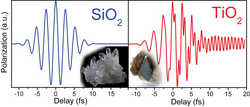Ultra-short light pulses from modern lasers allow the temporal resolution of even the fastest processes in molecules or solid-state materials. For example, after optical excitation, chemical reactions can be tracked down to a time scale of 10 fs (1 femtosecond (fs) = 10-15 seconds) on which the light field itself oscillates only a few times. However, there is a class of optical processes that have no measurable delay to the light field, and which have heretofore been considered "instantaneous". This includes the generation of optical harmonics in crystals, i. of light at multiples of the frequency of the radiated fundamental wave. This process creates the green light of a laser pointer made of invisible infrared light. The radiated frequency is in most applications far away from any resonance of the crystal to avoid absorption losses.
A nonlinear resonance catastrophe in the light of ultrashort pulses
Fig. 1: Reaction of SiO2 and TiO2 on a short pulsed light field. In SiO2, the deflection of the electron shell follows the field. After decay of the pulse also immediately ends this oscillation. In TiO2, on the other hand, the third harmonic of the excitation field resonantly exhibits an oscillation that persists even after the excitation has ended. For both materials, images of crystalline modifications are shown as inserts (photos by Didier Descouens, CC BY 3.0 and Rob Lavinsky, CC -BY-SA-3.0).
In a joint work, researchers from the Max Born Institute, the Weierstrass Institute and Leibniz University have shown for the first time that non-instantaneous behavior occurs even outside the resonances of the fundamental wave. Analysis of the third harmonic generated with extremely short light pulses in thin titanium dioxide layers reveals a decay of the generation process with a time constant of 8 fs, i. a non-contantaneous behavior. Although this is significantly longer than the duration of the shortest laser pulses currently available, this process still qualifies as one of the fastest ever time-resolved.
Animation 1: Reaction of SiO 2 and TiO 2 on a short pulsed light field. The electric field is represented by the central arrow. The resulting deflection of the electron shell is shown in a simple atomic image for both materials. The radiation in the third harmonic is indicated by a blue color of the shell. In SiO2 both the oscillations and the emission of the harmonics end with the end of the excitation pulse. In TiO2, on the other hand, a resonant rocking of the third harmonic is observed, which persists even after the end of the excitation pulse.
An in-depth theoretical modeling of this surprising observation shows that non-instantaneous behavior occurs only when the generated third harmonic is in the region of resonance of the optical material. Then the material excitation generated by the irradiated pulse oscillates for several light periods and radiates the third harmonic over this time interval. The process therefore appears as a kind of "resonance catastrophe", which - similar to classical mechanical oscillators - leads to a noninstantaneous response to the excitation
These results have important implications for measuring and generating ultrashort light pulses. Such methods are based on an instantaneous nature of the non-linear optical processes used. Similarly, as one should avoid military lock-step on bridges, one must therefore avoid the observed optical resonances in the measurement of short laser pulses.
Search publications of MBI
Publications since 2025
